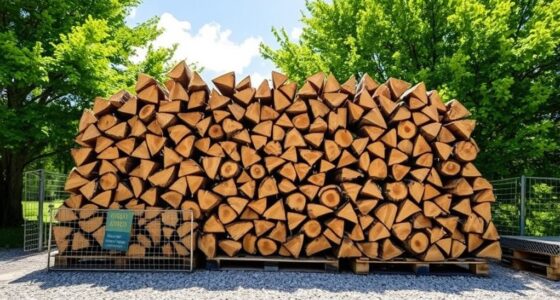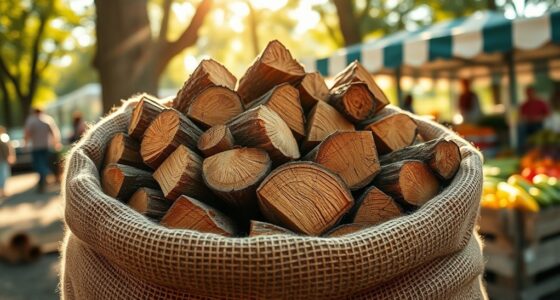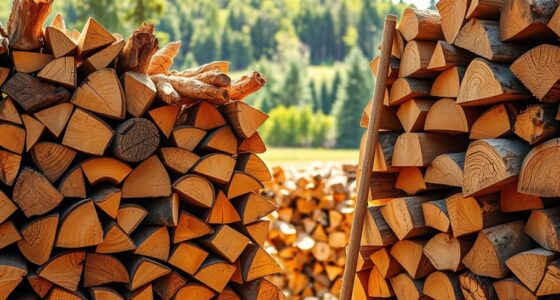Firewood quality standards focus on moisture content, species, and appearance to guarantee a clean, efficient burn. Look for seasoned wood, ideally with less than 20% moisture, and straight, solid logs without mold or cracks. Different grades range from prime to reject, indicating quality. Certifications like FSC also show responsible sourcing. Knowing these basics helps you choose better firewood; keep going to discover more details to improve your firewood selection.
Key Takeaways
- Moisture content below 20% ensures cleaner, more efficient combustion and reduces creosote buildup.
- Dense, straight, and crack-free logs indicate properly seasoned, high-quality firewood.
- Firewood grades (Prime, Select, Utility) categorize quality based on defects and bark presence.
- Properly labeled firewood provides information on moisture levels, species, and certifications like FSC or SFI.
- Selecting seasoned wood dried at least six months, with minimal defects and proper storage, guarantees better burning performance.
Key Factors in Firewood Assessment

When evaluating firewood quality, understanding the key factors can make all the difference in guaranteeing efficient burning and safety. First, check the moisture content; seasoned wood with less than 20% moisture burns cleaner and produces more heat. Next, consider the wood’s density—denser woods like oak or hickory generate more heat and last longer. Look for straight, solid logs without cracks or mold, as these indicate good quality and proper seasoning. The size and shape also matter; uniform pieces ignite more easily and burn evenly. Avoid wood with excessive sap, mold, or rot, which can produce smoke and creosote buildup. Additionally, understanding the chemical composition of different wood types helps predict combustion behaviors and emissions. Recognizing the impact of moisture on combustion efficiency is crucial for selecting optimal firewood. Moreover, knowing the seasoning process can help you determine whether the wood has been properly dried for optimal burning. By appraising these factors, you ensure you select firewood that burns efficiently, safely, and with minimal environmental impact.
Common Firewood Grades and Classifications

Have you ever wondered how firewood is categorized based on quality and usability? Firewood grades help determine how well it burns and how easy it is to handle. Typically, firewood is divided into three main categories: Prime, Select, and Utility. Proper classification standards ensure that you select the appropriate grade for your specific heating needs. Understanding these standards can also assist in firewood storage and handling practices to maintain quality over time. Following industry standards helps guarantee consistent quality and safety in your firewood supply. Additionally, knowledge of dog breeds can help in choosing a suitable companion for outdoor activities like firepit gatherings.
| Grade | Description | Typical Use |
|---|---|---|
| Prime | Clean, straight logs, minimal bark | Fireplaces, premium burning |
| Select | Slight imperfections, some bark | Campfires, wood stoves |
| Utility | Mixed, knotty, bark-heavy | Outdoor fire pits |
| Substandard | Poor quality, lots of knots or rot | Less desirable, kindling |
| Reject | Unsuitable, rotten or heavily damaged | Not recommended |
These classifications help you choose the right firewood for your needs, ensuring efficient and safe burning. Proper sorting based on firewood quality standards can also aid in better storage and handling.
Moisture Content and Its Impact on Quality

The moisture content of firewood substantially influences its burning performance and safety. When your wood has high moisture levels, it’s harder to ignite, and it produces more smoke, creosote buildup, and pollution. Wet wood also burns less efficiently, meaning you’ll need more fuel and end up with less heat. Excess moisture can cause dangerous chimney fires if creosote builds up from incomplete combustion. To guarantee safe, efficient burning, aim for firewood with moisture content below 20%. Properly seasoned wood feels lighter, produces a crackling sound when burned, and has cracks in the ends. Monitoring moisture helps you avoid inefficient fires and reduces health risks associated with smoke and emissions. Using moisture meters can help ensure your wood is properly seasoned before burning. Additionally, understanding seasoning techniques can improve the quality and safety of your firewood. Proper storage methods are also essential to keep firewood dry and prevent moisture absorption from the environment. Ensuring good ventilation around stored wood can significantly reduce moisture buildup. Incorporating effective drying methods can further enhance the seasoning process, leading to cleaner and more efficient fires. Dry, well-seasoned firewood not only burns cleaner but also lasts longer and provides better heat output.
How to Read Firewood Labels and Certifications

Understanding how to read firewood labels and certifications helps you select quality wood that burns efficiently and safely. Labels provide essential details like moisture content, wood species, and certification marks. Look for certifications such as the Forest Stewardship Council (FSC) or Sustainable Forestry Initiative (SFI), which indicate responsible sourcing. Pay attention to moisture content, ideally below 20%, for *ideal* burning. Check the label for the species to ensure it matches your heating needs. Also, verify if the wood is kiln-dried or seasoned, which affects combustion quality. Certifications and labels act as trustworthy indicators of quality, helping you avoid low-grade or improperly prepared firewood. Fostering digital literacy in firewood sourcing can also help ensure environmentally responsible choices. Being aware of firewood quality standards can further guide your selection process and promote sustainable practices. Recognizing proper seasoning techniques is crucial for maximizing burn efficiency and minimizing smoke. Additionally, understanding cultural heritage related to sustainable practices can deepen your appreciation for responsible sourcing.
Tips for Selecting High-Quality Firewood

Choosing high-quality firewood starts with paying close attention to its source and condition. Look for seasoned wood that’s been dried properly—preferably for at least six months—so it burns efficiently and produces less smoke. Check for cracks or splits in the logs, which indicate dryness, and avoid wood with excessive moisture or mold. Select logs that are uniformly colored and free of pests or fungi. When inspecting, listen for a hollow sound, suggesting dryness. If possible, confirm the wood is from a reputable supplier who adheres to sustainable harvesting standards. Properly stored firewood in a dry, covered area will be of better quality. Making these careful choices ensures you get wood that burns cleaner, lasts longer, and heats your home more effectively.
Frequently Asked Questions
How Does Firewood Quality Affect Indoor Air Quality?
When you burn low-quality firewood, you risk releasing more smoke, creosote, and harmful pollutants into your home. Poorly seasoned or damp wood produces excess smoke and particulate matter, which can irritate your lungs and worsen respiratory issues. High-quality, well-dried firewood burns cleaner, reducing indoor air pollution. So, choosing good firewood directly impacts your home’s air quality, making your space healthier and safer for you and your family.
Are There Regional Differences in Firewood Standards?
Back in the day, you’d think firewood standards were uniform everywhere, but today, regional differences really matter. You’ll find that standards vary based on climate, local regulations, and wood types. For instance, in colder regions, there’s often stricter quality control to ensure cleaner burning and better efficiency. So, you ought to verify local guidelines before purchasing, because what’s acceptable in one area might not be in another.
What Tools Are Best for Assessing Firewood Quality at Home?
When evaluating firewood quality at home, you should focus on tools that help you evaluate moisture, density, and split quality. A moisture meter is essential for checking if the wood is properly seasoned, ideally below 20%. A flashlight or your eyes can help spot cracks and mold, while a hammer or axe tests density and splitability. These tools ensure you select wood that burns efficiently and produces less smoke.
How Often Should Firewood Be Seasoned for Optimal Burning?
You should season your firewood for about 6 to 12 months to guarantee ideal burning. During this time, store it in a dry, well-ventilated area, off the ground, and covered to protect from rain. Check for dryness by splitting a piece and feeling the weight—seasoned wood is lighter and sounds hollow. Properly seasoned firewood burns cleaner, produces more heat, and reduces creosote buildup in your chimney.
Can Recycled or Reclaimed Wood Meet Firewood Quality Standards?
Imagine a pile of recycled or reclaimed wood, its weathered surface whispering stories of past fires. You might wonder if it meets firewood standards. Reclaimed wood can be a good choice if it’s free from paint, chemicals, or treatments. Properly dried and seasoned, it burns efficiently and cleanly. Just make certain it’s free of contaminants, and you’ll enjoy warm, eco-friendly fires without sacrificing quality.
Conclusion
Don’t let confusing labels or grades hold you back from choosing the best firewood. By understanding quality standards, you can confidently select firewood that burns cleaner, lasts longer, and heats more efficiently. Even if it seems complicated at first, knowing what to look for makes a big difference. With a little knowledge, you’ll enjoy a cozy, safe fire every time—so go ahead, pick the right firewood and warm up your home the smart way.








